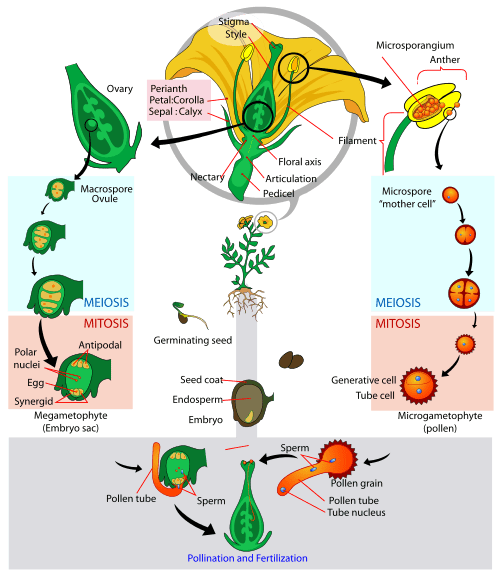Reproduction in Angiosperm Plants

Reproduction in angiosperm plants involves the production of seeds through sexual reproduction. This process typically includes the formation of flowers, pollination, fertilization, and the development of fruits and seeds. Here are the key stages of reproduction in angiosperms:
-
Flower Formation:
- Angiosperms produce reproductive structures called flowers, which contain both male and female reproductive organs. Flowers can be unisexual (containing either stamens or carpels) or bisexual (containing both stamens and carpels).
-
Pollination:
- Pollination is the transfer of pollen from the male reproductive organs (anthers) to the female reproductive organs (stigmas) of a flower. Pollen can be transferred by wind, water, insects, birds, bats, or other animals.
-
Fertilization:
- After pollination, pollen tubes grow down the style to reach the ovule in the ovary. The process of fertilization involves the fusion of a sperm cell with an egg cell within the ovule. This results in the formation of a diploid zygote.
-
Seed Development:
- The fertilized egg, or zygote, develops into an embryo within the ovule. The ovule matures into a seed, consisting of the embryo, stored nutrients, and a protective seed coat. The surrounding ovary develops into a fruit.
-
Fruit Development:
- The ovary wall develops into a fruit that surrounds and protects the seeds. Fruits serve various functions, such as attracting animals for seed dispersal, providing nutrients to developing seeds, and offering protection.
-
Seed Dispersal:
- Once the seeds are mature, the fruit facilitates their dispersal. This can occur through various mechanisms, such as wind, water, animals, or even explosive mechanisms in some cases. Dispersal enhances the chances of the seed germinating in a new location.
-
Germination:
- Germination is the process by which a seed develops into a new plant. It begins with the absorption of water, followed by the activation of enzymes that break down stored nutrients in the seed. The embryo resumes growth, and a seedling emerges from the seed.
-
Vegetative Reproduction:
- In addition to sexual reproduction, some angiosperms can reproduce vegetatively. This involves the development of new plants from non-reproductive plant parts, such as stems, roots, or leaves. Common methods of vegetative reproduction include runners, rhizomes, tubers, and bulbs.
The reproductive processes in angiosperms are vital for the continuation of their species and contribute to the remarkable diversity and adaptability of this group of plants. The variation in reproductive strategies, such as pollination mechanisms and seed dispersal methods, has played a key role in the success of angiosperms in diverse environments.
Thank you.
